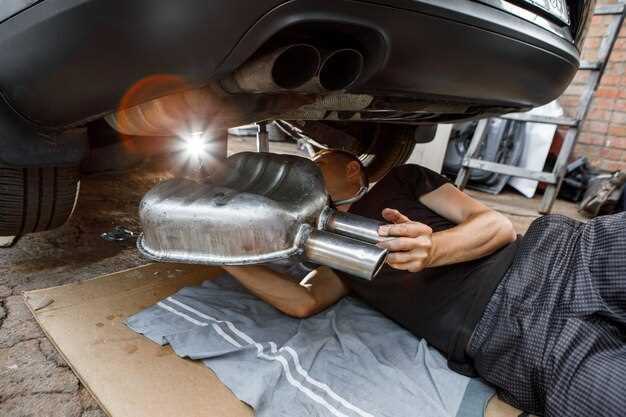
Repairing Audi Exhaust Leaks – What to Know

Exhaust leaks can be a significant issue for Audi owners, impacting both performance and fuel efficiency. Understanding how to identify and fix these leaks is crucial for maintaining your vehicle’s health. In this guide, we will explore the common causes of exhaust leaks in Audi vehicles and provide detailed steps on how to effectively address them.
Recognizing the signs of an exhaust leak is the first step towards finding a solution. You may notice unusual noises, reduced acceleration, or a check engine light appearing on your dashboard. These symptoms can indicate that there is a leak in the exhaust system, which not only affects your car’s performance but can also lead to more serious problems if left untreated.
In this comprehensive guide, we will walk you through the process of diagnosing and fixing exhaust leaks in your Audi. We will cover essential tools and materials needed for the fix, as well as step-by-step instructions to ensure that you can address the issue effectively and safely. By the end, you will have the knowledge required to tackle exhaust leaks with confidence, ensuring your Audi runs smoothly and efficiently.
Identifying Common Exhaust Leak Symptoms in Audi Vehicles

Exhaust leaks in Audi vehicles can lead to various performance issues and may compromise your driving experience. Recognizing the signs of a leak early can save time and costs associated with repairs. Here are some common symptoms to look out for:
1. Unusual Noises: One of the first indicators of an exhaust leak is an increased noise level. You may notice a loud or rumbling sound while accelerating, which is often caused by exhaust gases escaping through gaps. This sound may vary from a hissing to a popping noise, particularly noticeable during cold starts.
2. Decreased Fuel Efficiency: If your Audi begins to consume more fuel than usual, an exhaust leak could be the culprit. An inefficient exhaust system can disrupt the air-fuel mixture, leading to incomplete combustion and, ultimately, decreased mileage. Monitoring fuel consumption is key to identifying potential leaks.
3. Check Engine Light: A leak can trigger diagnostic trouble codes, causing the check engine light to illuminate on your dashboard. Investing in an OBD-II scanner or consulting a professional can help determine if an exhaust leak is the reason behind the warning light.
4. Strong Odor of Exhaust Fumes: If you detect a strong smell of exhaust gases inside or near your vehicle, it may indicate a leak. This is particularly concerning as exhaust fumes contain harmful gases that can affect your health. Promptly addressing this symptom is crucial for your safety.
5. Visible Damage: Occasionally, you may be able to visually inspect your exhaust system. Look for signs of rust, holes, or damage to exhaust pipes, mufflers, and gaskets. Any visible deterioration can lead to a leak. Regular inspections can help you identify potential issues before they escalate.
Addressing these symptoms early by consulting with a qualified technician can help you effectively fix any issues related to exhaust leaks, ensuring your Audi remains in top condition.
Step-by-Step Process for Locating and Sealing Exhaust Leaks

Identifying an exhaust leak in your Audi is critical for maintaining performance and efficiency. Follow these steps to accurately locate and fix the leak.
Start with a visual inspection. Check all connections and joints in the exhaust system, including the manifold, pipes, and muffler. Look for any signs of rust, corrosion, or visible gaps that may indicate a leak.
Next, listen for unusual sounds. With the engine running, pay attention to any hissing or popping noises that may suggest escaping exhaust gases. This is often a telltale sign of a leak.
Employ the soapy water method as a more precise detection technique. Mix soapy water in a spray bottle and apply it to suspected areas of the exhaust system while the engine is running. If bubbles form, you have identified the location of the leak.
Once you locate the leak, prepare the area for sealing. Clean the surface around the leak thoroughly, removing any dirt, rust, or old sealant. This ensures a strong bond for the fix.
Select the appropriate sealing method based on the severity of the leak. For minor leaks, a high-temperature exhaust sealant may suffice. For larger gaps or cracks, consider using exhaust repair tape or replacement components like flanges or clamps.
Apply the sealant or tape according to the manufacturer’s instructions. Ensure an even application to maximize effectiveness. Allow sufficient curing time as specified before running the engine again.
After sealing, restart the engine and recheck the repaired area. Listen again for any abnormal noises and inspect for leaks using the soapy water method to confirm a successful fix.
Regular maintenance and inspections can prevent future leaks. Ensure that all parts of your Audi’s exhaust system are in good condition to maintain optimal performance.
Tools and Materials Needed for Audi Exhaust Leak Repair
When you need to fix an exhaust leak in your Audi, having the right tools and materials is essential for a successful repair. Below is a comprehensive list of what you will need to effectively address the issue.
Tools:
- Socket Set: A complete socket set is necessary to remove and tighten bolts on the exhaust system.
- Ratchet Wrench: This tool will help you access tight spaces when loosening or tightening connectors.
- Pliers: Pliers are useful for gripping and bending components as needed during repairs.
- Torque Wrench: To ensure all bolts are tightened to the manufacturer’s specifications, a torque wrench is vital.
- Cutting Tool: A saw or pipe cutter may be needed if you must replace sections of the exhaust pipe.
- Jack and Stands: Lifting your Audi safely will provide access to the exhaust system under the vehicle.
Materials:
- Exhaust Sealant: This high-temperature sealant is essential for sealing any gaps or cracks in the exhaust system.
- Replacement Gaskets: Fresh gaskets are crucial for ensuring a proper seal at connection points.
- Exhaust Pipe Repair Tape: This tape can temporarily fix small leaks in the exhaust pipe before a more permanent solution is applied.
- New Exhaust Pipes: If severe rust or damage is present, replacing sections of the exhaust pipe will be necessary.
- Heat Resistant Gloves: Protect your hands when working with hot components of the exhaust system.
By gathering these tools and materials, you will be well-prepared to tackle any exhaust leak repair on your Audi efficiently and effectively.